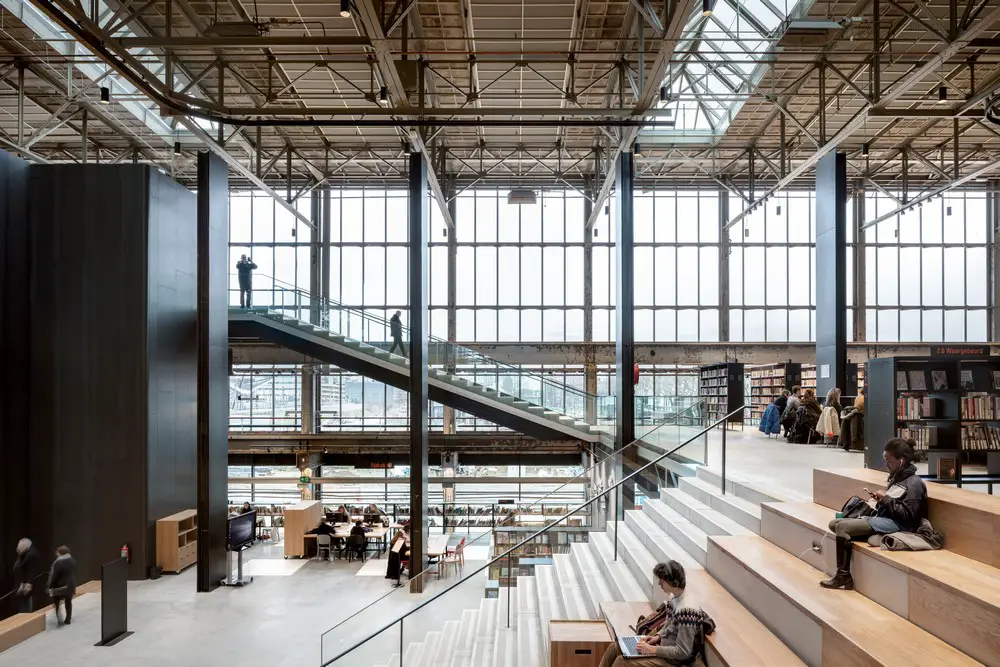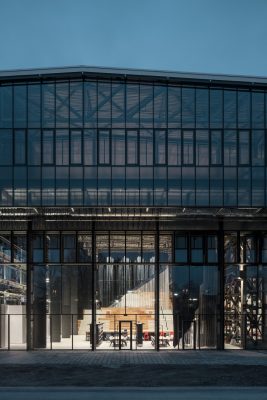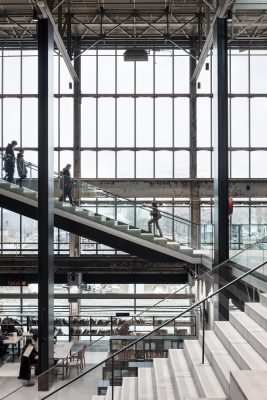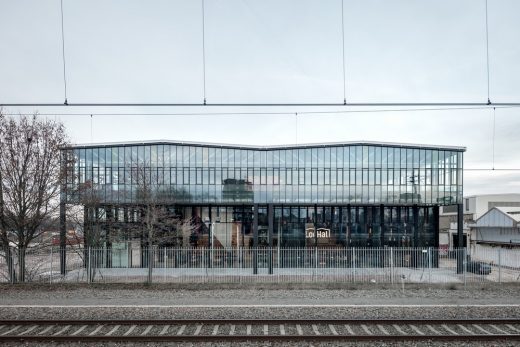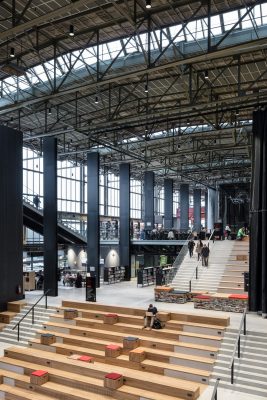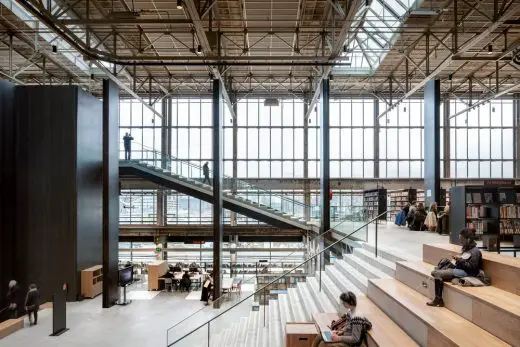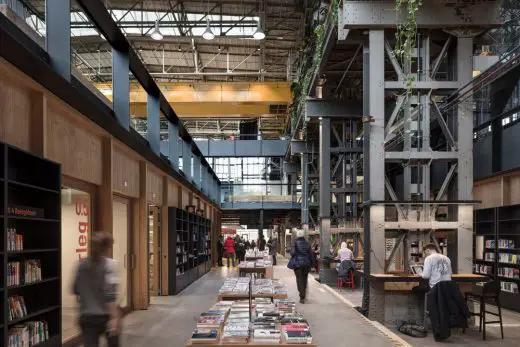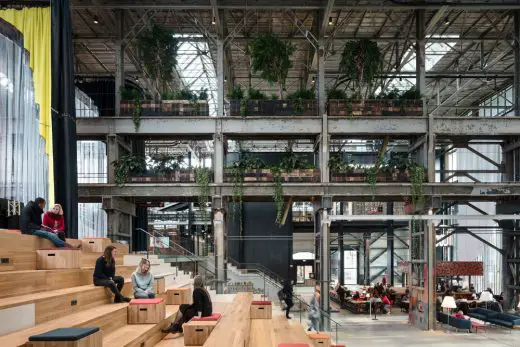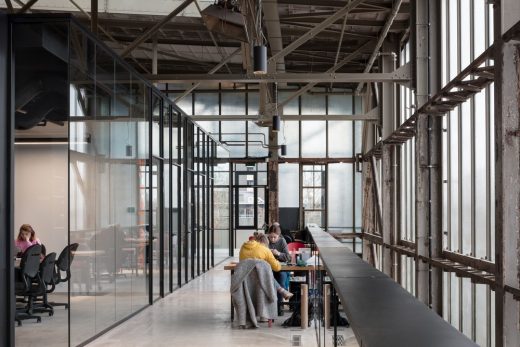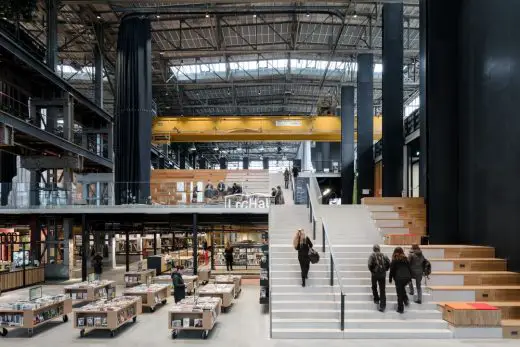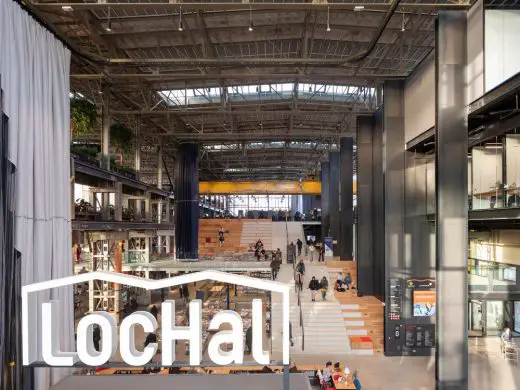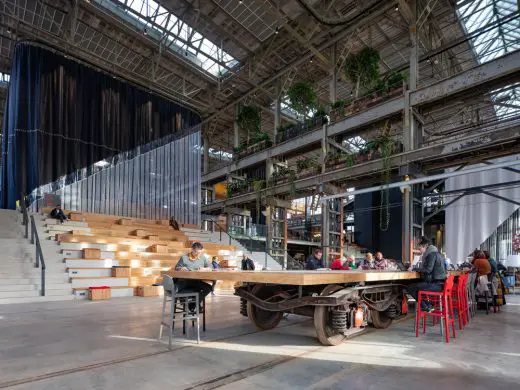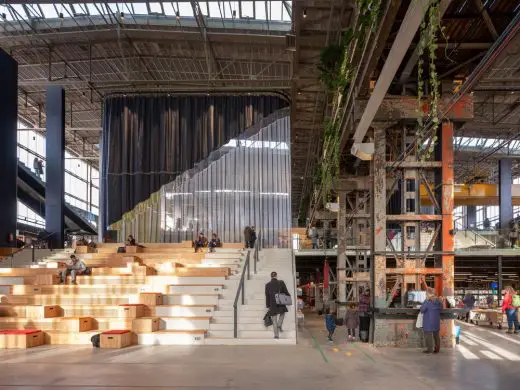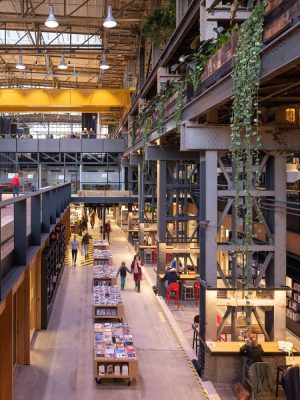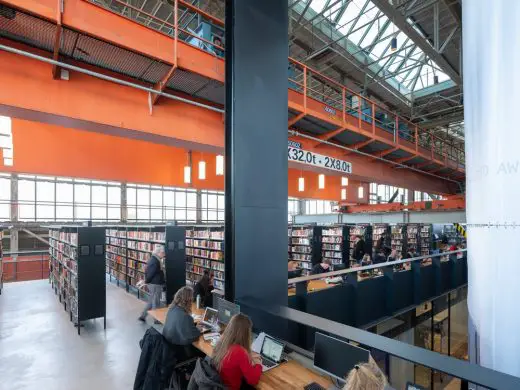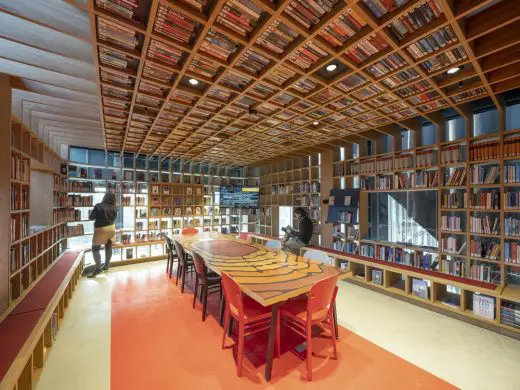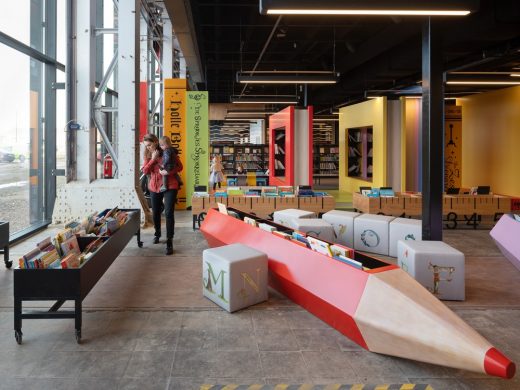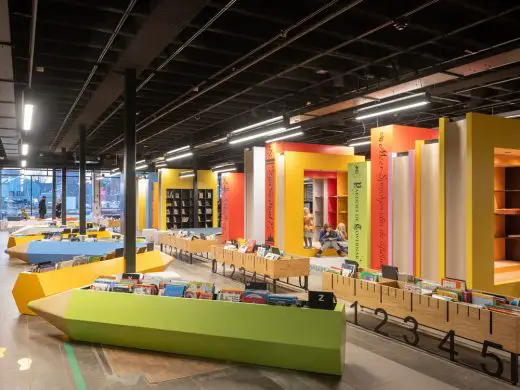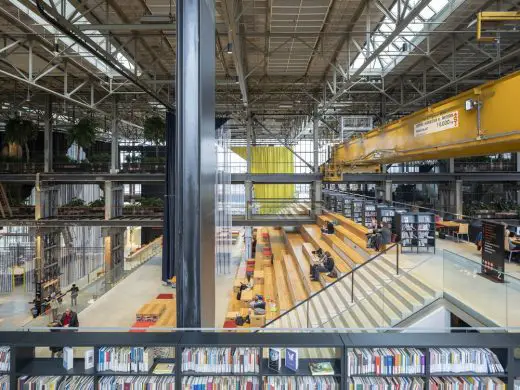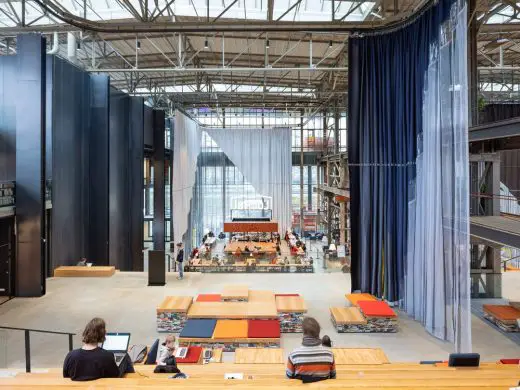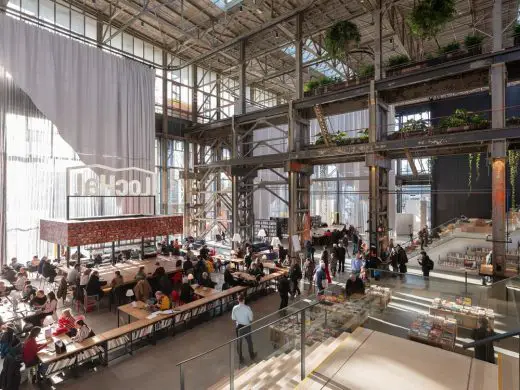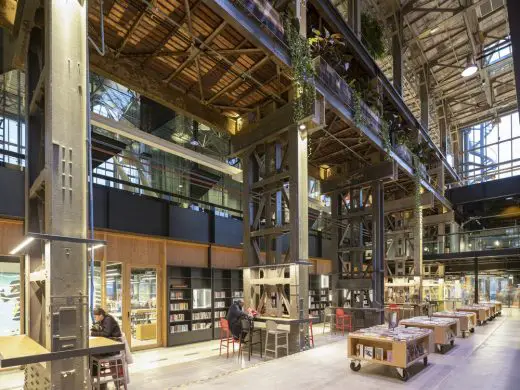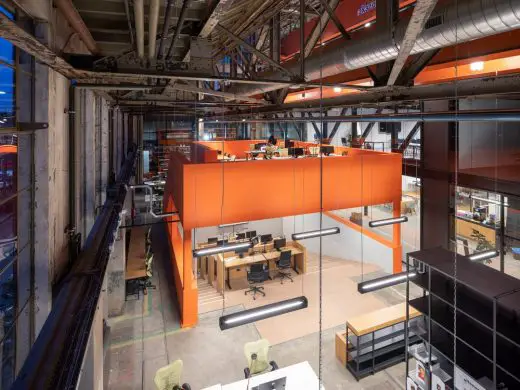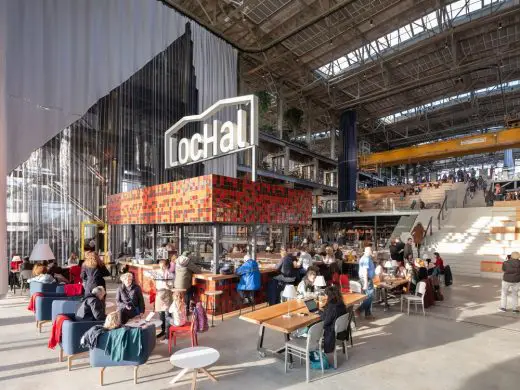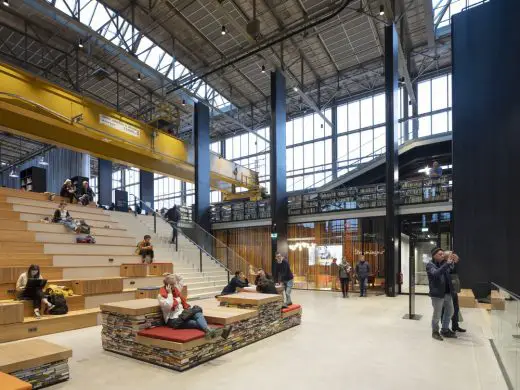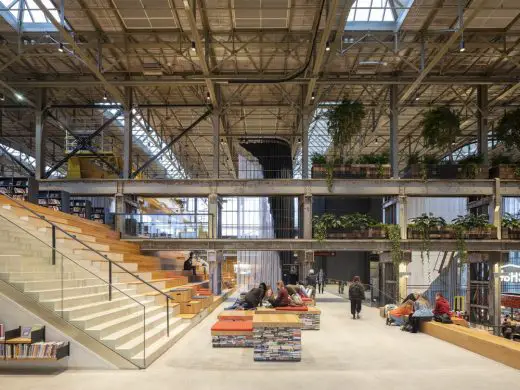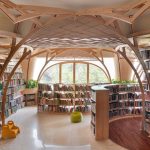LocHal Library in Tilburg building design, Netherlands public architecture, Dutch civic interior project images
LocHal Library in Tilburg
Community Building Development in Holland – design by CIVIC architects ; interior design by Mecanoo architecten, NL
27 Jan 2019
Architect: CIVIC architects ; Interior Design: Mecanoo architecten
Location: Tilburg, The Netherlands
Colossus of industrial heritage becomes public library
The architecture of the LocHal in Tilburg
Visitors to Tilburg’s newly modernized station district will notice an exciting addition to the city: the new public library which was officially opened in January 2019. A former locomotive shed – the ‘LocHal’ – has undergone an intensive redesign to become the beating heart of the district. It has been transformed into a public meeting place with a distinct railway theme. Its rugged steel structure provides the perfect backdrop for all manner of events and exhibitions.
Photos by Stijn Bollaert
LocHal Library Tilburg
Much of the elegant industrial building has been conserved. With the addition of robust new architecture and huge textile screens, it has been transformed to showcase the new concept of Midden Brabant Libraries. It is a place in which knowledge is not only ‘consumed’ but produced by partners such as the arts organization Kunstloc, Brabant C and the co-working facilities of Seats2Meet. The building’s design is the result of close collaboration between Civic Architects, Braaksma & Roos Architectenbureau and Inside Outside/Petra Blaisse. The interior design of the library, the various ‘laboratories’, the café and offices are by Mecanoo, while the engineering consultancy Arup advised on aspects such as sustainability, re-use and acoustic design.
A public meeting place
Perhaps the most conspicuous feature of the new LocHal is its sheer size. With a footprint of 90 x 60 metres and a height of 15 metres, it is both imposing and inviting. The new library was deliberately designed to be an extremely accessible building. The entrance hall takes the form of a covered city square with large public reading tables (doubling as podia), an exhibition area and a coffee kiosk. This square is flanked by broad steps which can be used as event seating for over one thousand spectators. These steps lead up into the main building, notable for the huge glass facades which allow for plentiful daylight. On the second floor, the gallery and stairways allow closer inspection of the historic glass walls as visitors browse the bookcases or make use of the quiet reading areas. One floor higher is a large balcony offering panoramic views of the city.
A library for the 21st century
The LocHal has redefined the function of a library in today’s digital era. While there are the usual facilities for the traditional ‘book consumer’, the new library also provides ample opportunity for the creation of new knowledge. ‘Curatorship’ has become just as important as the books themselves: interaction with human experts offers a deeper, richer way to acquire knowledge and information. This new role is facilitated by the architecture. In addition to various areas for lectures and public events, the library has a number of ‘labs’ (laboratories) where visitors can learn new skills. These labs, with their remarkable design, can be found throughout the building. One is in the form of a glass cube, formerly part of the concert hall in Amsterdam’s Beurs van Berlage building. There is also the Food Lab, the Word Lab, the DigiLab and the Heritage Lab. The clustering of library, various arts institutes, Seats2Meet and faculties of journalism in the nearby Mindlabs (currently under construction) creates a diverse group of experts who will cement the success of the new library concept. Moreover, the form of the building ensures that the collection, the facilities and the manner in which they are used can be adapted to meet changing requirements.
A robust decor
The atmosphere of the building is that of a productive knowledge institute. The main structure, various original features which have been carefully preserved and the new additions make use of ‘honest’ materials such as black steel, concrete, glass and wood, applied over large surfaces. Textile screens add accents of scale and colour. It is the main structure which determines the architectural language, while the details adapt themselves to the scale of the building. Floors, columns and stairways reveal their characteristic textures when viewed at close hand, especially in daylight when the refined shadows created by the intricate window frames and translucent textile panels play upon them. After dark, the building is turned ‘inside out’, as it were, with the interior becoming the main source of light: an inviting beacon in the city centre. The interior then takes on the character of a theatre, with all surfaces bathed in a warm light. The imperfections of the existing materials contribute much to the authentic atmosphere of the LocHal. The architecture creates a colossal, industrial setting for all types of activity. The interior design, with its unique fixtures and fittings, creates an extra layer that adds playful variation to the overall visual experience.
Textile screens
Amid all this openness, certain events and activities may call for a smaller scale or a degree of privacy. Inside Outside has therefore designed six huge textile screens which extend to ceiling height, thus accentuating the scale of the building while also defining separate areas and improving the acoustic properties of the interior. These screens have a total surface area of 4125 m2 and can be repositioned using a computerized system. They can, for example, be moved to separate the Seats2Meet area from the higher library floors, or across one of the staircases to create a small, semi-private auditorium. The largest screens, 50 metres across and 15 metres high, can be used to conceal the coffee kiosk or create the perfect backdrop for it. When positioned in front of the windows on the south side of the building, the screens soften the light that floods through the tall glass facades into the inner square.
Harmonious architecture
The new architectural design is a contemporary reinterpretation of that of the original late-industrial building, dating from 1932, and builds upon the logic of that design. The impression of spaciousness is strengthened by new sightlines across the diagonally stepped interior landscape. Columns, floors, balustrades and the textile screens form the ‘grand gestures’ of the various axes within the spatial system: directly up, behind and to the sides, a reference to the industrial processes of the past. The original riveted columns have been preserved and are joined by large supporting structures in a more abstract form which delineate the side aisles they create.
Variation in interior style
The interior design employs a number of distinct concepts to create different settings for various activities such as meeting, collaboration or quiet reading. Characteristic original features have been combined with oak, steel and a palette of red and orange hues. The coffee kiosk is finished in red, brown and gold ceramic tiles. Three huge tables, designed in the form of a train’s ‘bogie’ (undercarriage), stand on the original tracks. They form an extension to the bar area but can also be pushed together to create a stage or catwalk, with the surrounding steps providing seating for the audience. The immense industrial columns have been repurposed as reading and study areas by the addition of wooden tables and lighting. The library’s collection is arranged on large, movable bookcases to create the inviting atmosphere of a modern bookstore. There is also a children’s library, the design of which draws inspiration from De Efteling, the fairy-tale theme park near Tilburg. Young visitors can wander through giant storybooks and browse bookcases in the form of coloured pencils and rulers.
Adaptive technology
The technical aspects of the LocHal design are based on a phased approach whereby the possibilities offered by the existing building are used to the greatest extent possible and additions are made only where absolutely necessary. The result is a structure which uses the full load-bearing strength of the original floors and beams, which were after all designed to support heavy locomotives. Similar restraint underpinned the structural engineering concept and installation technology. The degree to which an area has artificial climate control depends entirely on its function, whereby the principle of ‘heat the people, not the space’ has been applied. An ingenious system of five separate climate zones ensured that physical adaptations could be kept to a minimum. It was then possible to undertake the transformation of the enormous volume of the LocHal rather than the more radical intervention of replacing it.
A design team of experts
The various design aspects are very much interdependent. A large number of companies and individuals were involved, each contributing their specific area of expertise to create a single, superlative design. The architects for the project were selected by means of a design competition and the winning entry was submitted by a partnership of three firms. Civic Architects, a leading expert in public architecture joined forces with Braaksma & Roos (known for its expertise in the transformation of industrial heritage) and Inside-Outside/Petra Blaise, experts in interior and landscape design with extensive experience in textile-based interventions. The design team enjoyed the support of the engineering consultancy Arup. Interior fixtures and fittings in the library, the café, the laboratories and the offices were designed by Mecanoo. Inside Outside designed the six textile screens which were produced with the assistance of the Tilburg Textile Lab. The interiors of the Seats2Meet areas were designed with the input of architecture students at Fontys University of Applied Sciences. Lead contractor for the implementation phase was Binx, working under the guidance of VDNDP Architects.
LocHal Library in Tilburg – Building Information
Commissioning client: City of Tilburg
Total project area: 11200 m2
Programme: Bibliotheek Midden-Brabant (public library), Seats2Meet, BKKC, Kunstbalie, catering facilities, events areas
Lead architect: Civic Architects
Transformation and restoration: Braaksma & Roos Architectenbureau
Interior and landscape design, textiles: Inside Outside / Petra Blaisse
Landscaping: Donkergroen
Interior design library & offices: Mecanoo
Advisors to City of Tilburg
Construction management: Stevens van Dijck Bouwmanagers & Adviseurs
Technical consultancy: Arup (structural design and engineering, installation technology, sustainability, lighting, fire safety, acoustic design)
Lead contractor: Binx Smartility
Consultants: VDNDP Structural Engineers (site architect)
F. Wiggers Ingenieursbureau (structural engineering)
ABT Wassenaar (building physics, acoustics, fire safety)
SOM= (commercial management)
Linneman (BREEAM certification)
Glass hall Zaanen Spanjers Architecten
Octatube
Textile screens
Design drawings and installation: Inside Outside/Petra Blaisse (NL)
Woven sections: Tilburg Textile Museum (NL)
Canvas sections and installation: Seilemaaker (NL)
Assistant canvas sections: Gerriets France (FR)
Monofilament sections: Theatex BV (NL)
Rails and motorized system: Gerriets Gmbh (DE)
Installation and software: Levtec (NL)
Photographs © Stijn Bollaert
(Other illustrations © Civic Architects)
Further information: Gert Kwekkeboom ([email protected] / +31 630343224)
THE CORE DESIGN TEAM
Civic Architects
Civic Architects specializes in public buildings. We design libraries, bridges, theatres, concert halls, art galleries, museums, civic buildings, squares, schools, residential complexes, sculptures and stations. We believe that architecture is a public interest. All buildings form part of the human environment in which people live, work and interact. Our designs therefore respect and anticipate social, cultural, economic and ecological requirements. Civic currently has a staff of ten architects led by four managing partners. We approach each design on various levels of scale and always work with and alongside the best specialists. The result is functional and aesthetically responsible architecture which will serve the needs of generations to come.
Braaksma & Roos Architectenbureau
Braaksma & Roos Architectenbureau is a leading expert in the repurposing of unique industrial heritage. For over 35 years, we have dedicated ourselves to complex transformation and renovation projects in which we incorporate appropriate contemporary design elements. Based on an in-depth understanding of the unique characteristics of each building or site, our team seeks creative, sometimes surprising, solutions. We therefore create the optimum balance between the values of the past and the requirements of the future to ensure meaningful and sustainable usage.
Inside Outside – Petra Blaisse
Inside Outside/Petra Blaisse is a multidisciplinary design agency founded by Petra Blaisse in 1991. It specializes in interior and landscape architecture and has extensive experience in exhibition design. Petra Blaisse has been involved in in designing architectural exhibitions since 1987 and is well known for her use of large-scale textile screens in public buildings, art installations and – on occasion – private homes. Inside Outside has an international client base. Alongside its design activities, it also runs lectures and workshops for students at home and abroad. Two partners joined the firm in 2016: landscape architect Jana Crepon and architect Aura Luz Melis.
LocHal Library Tilburg images / information received 270119 from Civic Architects
Previously on e-architect:
18 Jan 2019
LocHal Library
Architect: CIVIC architects ; Interior Design: Mecanoo architecten
Location: Tilbury, The Netherlands
LocHal, a world-class library for Tilburg
Mecanoo completed interior design for the LocHal Library
The LocHal, an old locomotive hall dating from 1932, is located next to the station of Tilburg and houses the Bibliotheek Midden-Brabant, Kunstloc Brabant, Brabant C and Seats2Meet*. Everyone is welcome in the new living room of Tilburg, a world-class space for both young and old to read, learn and study, meet and gather. It is a place for testing, creating, exhibiting and presenting the latest innovations.
* Bibliotheek Midden-Brabant (public library), Kunstloc Brabant (a regional knowledge and expertise centre for culture and art), Brabant C (a regional investment fund for culture and the creative industry) and Seats2Meet (co-working spaces)
History
Tilburg is not only known for its worsites of the Dutch National Railways, but also for its textile industry and the Efteling, the nearby popular fairytale theme park. This history is made tangible in Mecanoo’s interior design. Characteristic historical elements form an exciting combination with new oak and steel additions, and a warm colour palette of reds and oranges. The interior is varied, playful and innovative. There is a diversity of atmospheres for meeting, collaboration, and concentrated work.
City café with reading and exhibition space
The eye-catcher is the city café featuring a bar with red, brown and gold ceramic tiles and a neon LocHal logo on top. It can easily be spotted from passing trains. The old tracks are visible in the concrete floor. They are used to move three large wheeled “train” tables. For example, a single table can become the extension of the bar; when placed together, the tables form a stage or catwalk with the stairs as a tribune. They can even be moved outside along the tracks to form a stage for events on the square. Next to this city café is the reading room with magazines, and next to that is the Kunstloc exhibition space. It is right in the corner, clearly visible from the outside. The textile walls designed by Inside Outside, inspired by Tilburg as a textile city, create intimate spaces in this large hall. When these hanging textiles are drawn together, the space can accommodate large-scale events.
Interior street
Crossing the building is an interior street lined with historic industrial columns on which the old layers of paint are still visible. By fitting the columns with wooden tables and lighting, they are given a new lease of life as places for reading and studying. The street is flanked by bookcases. There are also low mobile display units where books are presented invitingly, as in a bookshop. In this book street, books are also checked in and out. The bookcase wall on the office side has transparent display cases for works of art and unique books. This wall also gives staff the right balance between privacy and connection with the library.
Children’s library with Efteling atmosphere
The Efteling theme park is the source of inspiration for the children’s library. Bookcases take on the form of colored pencils or rulers. You can walk through the giant fairytale books, look for a book or play. The little ones can read a book at tables shaped like mobile phones, or listen to storytelling sessions while lying on an open book. Even the sitting poufs have playful letters in the form of fairytale animals.
Youth zone with GameLab
The youth zone is animated with colorful train seats and tables that offer space for different learning settings, such as concentrated work, collaboration and meeting. This zone also features the GameLab, one of the building’s many ‘laboratories’.
Stair landscape
The stair landscape that Civic designed for the monumental LocHal takes you to the upper floors. Parts of the stairs are made of oak. With the flexible wooden seating elements, everyone can design their own space. For instance, you can ‘build’ a meeting place or a quiet place to work undisturbed.
Library as laboratory
The LocHal is not only a library, but also a laboratory where you are challenged, gain new knowledge and learn about new innovations. These specially designed labs can be found throughout the building.
DigiLab
In the DigiLab, young and old can experiment with new media and the most modern hardware and software. You can edit photos and videos or create your own games. There are 3D printers and a green screen for filming. The DigiLab has a wall of shelves filled with appliances and integrated workspaces behind playfully perforated metal doors in bronze, silver and gold.
Workshop rooms
There are three workshop rooms between the children’s library and offices. With their flexible walls, they can easily be configured as two separate spaces or combined as one large space. These workshop rooms can be accessed by external people via the library and by the staff via office-side access points.
GameLab
The GameLab is for gamers. The oval space with blue perspex walls is located in the youth zone. The old circuit board – which you used to find in televisions – appears as a graphic element that marks the entrance. Inside, you are challenged through games to think creatively, to solve problems and to work together in the central space or individually in one of the four semi-circular niches.
FutureLab
The FutureLab is for future thinkers. Here, start-ups, students or companies can give presentations and organize workshops about manufacturing processes and innovative products. The digital screen, spanning the entire width of the wall, contrasts with a wall of playfully staggered end-grain wood. Through the play of shadow formed by the protruding and receding pieces of wood, the wall appears as a lively work of art.
Mobile FoodLab
The FoodLab is for food lovers. There is always something to taste, smell, see or feel. But there is also food for thought in this mobile oak-and-steel kitchen. Because it is on wheels, the FoodLab can also be used at events in the LocHal.
KennisMakerij (LearningLab)
The KennisMakerij can be found on the first floor. It is the big stage built from old books. They are stacked in different heights and topped with an oak counter. During a meet-up, lecture or performance, you can sit on the ‘stair tribune’, which connects the first and second floors. The open character of the space invites discussion during book presentations and debates.
TijdLab (TimeLab)
In the TijdLab, you can wander through the past, present and future of the city of Tilburg. Not only does this area contain the Tilburg Collection of the Library, but also all kinds of objects, photographs and films about the city. The TijdLab can be recognized by the white checkered floor and is located on the first level. By exploring the objects in display cases, we zoom in on specific themes. There are also oak tables – with a poem here and there – for concentrated or collaborative activities.
StemmingMakerij (DialogueLab)
The StemmingMakerij is for people who want to make their voices heard. In this enclosed space, there is room for sixty people during meet-ups, shake-ups, presentations or workshops. The colourful round benches can be arranged in different ways. The digital screen can be used for presentations and films. A colourful curtain of strings is hung on the acoustic and glass walls. Not only is this curtain playful and inspiring in terms of design, but it also symbolizes our colourful society where there is room for different opinions.
WoordLab (WordLab)
The WoordLab is an incubator and meeting place for lovers of language, literature and creative writing. Here, you are surrounded by books: on the shelves and even on the ceiling. This special space at the top of the LocHal houses the extensive linguistics and literature collection. A screen is built into the bookcases and is covered by doors that are integrated into the shelves. The wooden table with an abstract printed pattern consists of four parts, so that you can either work together or in groups.
Offices
The Library, Kunstloc and Brabant C share the office area, which offers a wide range of workplaces. There are open office spaces, ‘touchdown’ places for short tasks, places for collaboration, meeting places and a coffee corner. A wall of oak bookcases separates the office area from the interior street. Lockers are interspersed with transparent display cases, forming a playful composition. On the south side, there are tall steel cabinets that define work and meeting places.
A lowered working pit, where oil was once collected, has been transformed into an orange furniture element. This element includes a mezzanine level with places for concentrated work and a view to the outside. The playfully staggered stairs serve as an informal workplace and lead to the lowered working pit. The stairs also double as seating for staff lectures and presentations, with the working pit as a lowered stage.
Programme: Mecanoo was responsible for the interior design of the Bibliotheek Midden-Brabant, Kunstloc Brabant and Brabant C in a former locomotive hall of the Dutch National Railways. The interior design comprises 7,000 m2 including 1,300 sqm of offices.
LocHal Library Tilburg – Building Information
Architect: CIVIC architects
Restoration architect: Braaksma & Roos architectenbureau
Interior concept and textiles: Inside Outside and TextielMuseum
Interior design: Mecanoo architecten
Design: 2016-18
Realisation: 2018
Client: Bibliotheek Midden-Brabant and Kunstloc Brabant
Structural / mechanical / acoustic / lighting consultant: Arup, Amsterdam
Photography: Ossip Architectuurfotografie
LocHal Library in Tilburg images / information received 180119 from Mecanoo architecten
Location: Tilburg, Netherlands
Architecture in The Netherlands
Contemporary Dutch Architecture
Netherlands Architecture Designs – chronological list
Marga Klompé Building, Tilburg: First mass-timber academic building in Europe
Architect: Powerhouse Company
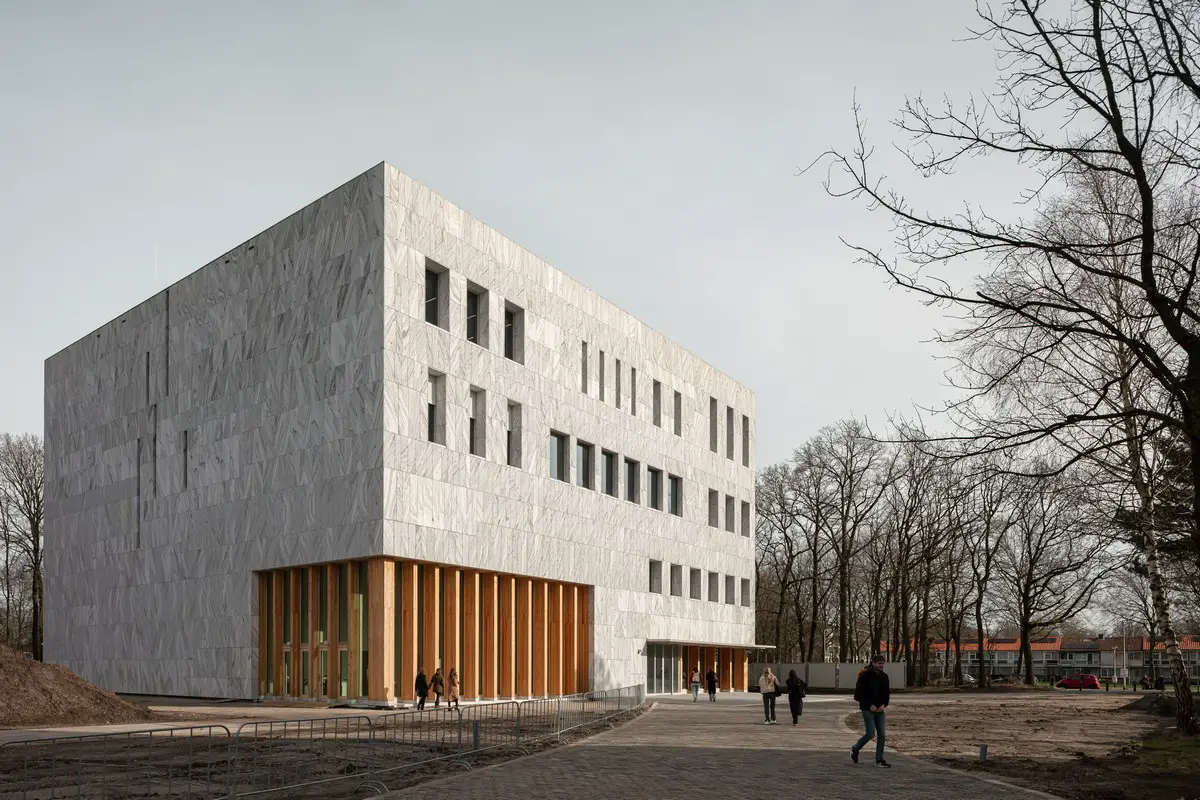
image : Powerhouse Company
Circular Cube, Tilburg University Lecture Hall
Amsterdam Architecture Walking Tours by e-architect
New Library Buildings – chronological list
Cartesiusdriehoek Blue District, Utrecht, Netherlands
Architects: Mecanoo architecten
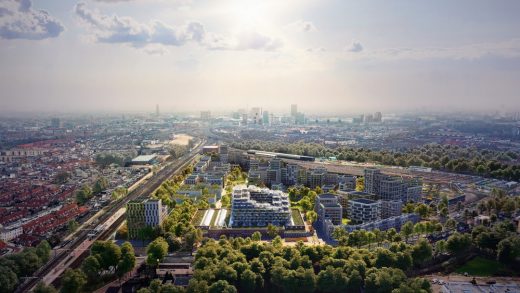
image courtesy of architecture office
Cartesiusdriehoek Blue District Utrecht
, Den Haag, The Netherlands
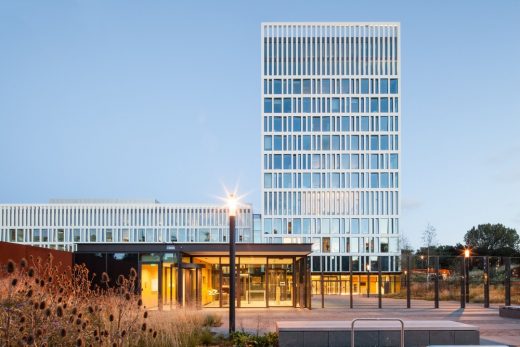
photo from architects office
Eurojust Den Haag
Dutch Architect – design firm listings
Amphion Theatre Building by Mecanoo
Comments / photos for the LocHal Library in Tilburg page welcome

